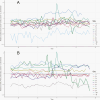Comparison of Administrative Database-Derived and Hospital-Derived Data for Monitoring Blood Culture Use in the Pediatric Intensive Care Unit
- PMID: 37417679
- PMCID: PMC10895403
- DOI: 10.1093/jpids/piad048
Comparison of Administrative Database-Derived and Hospital-Derived Data for Monitoring Blood Culture Use in the Pediatric Intensive Care Unit
Abstract
Background: Optimizing blood culture practices requires monitoring of culture use. Collecting culture data from electronic medical records can be resource intensive. Our objective was to determine whether administrative data could serve as a data source to measure blood culture use in pediatric intensive care units (PICUs).
Methods: Using data from a national diagnostic stewardship collaborative to reduce blood culture use in PICUs, we compared the monthly number of blood cultures and patient-days collected from sites (site-derived) and the Pediatric Health Information System (PHIS, administrative-derived), an administrative data warehouse, for 11 participating sites. The collaborative's reduction in blood culture use was compared using administrative-derived and site-derived data.
Results: Across all sites and months, the median of the monthly relative blood culture rate (ratio of administrative- to site-derived data) was 0.96 (Q1: 0.77, Q3: 1.24). The administrative-derived data produced an estimate of blood culture reduction over time that was attenuated toward the null compared with site-derived data.
Conclusions: Administrative data on blood culture use from the PHIS database correlates unpredictably with hospital-derived PICU data. The limitations of administrative billing data should be carefully considered before use for ICU-specific data.
Keywords: Pediatric Health Information System; Pediatric Intensive Care Unit; administrative data; blood culture use; diagnostic stewardship.
© The Author(s) 2023. Published by Oxford University Press on behalf of The Journal of the Pediatric Infectious Diseases Society. All rights reserved. For permissions, please e-mail: journals.permissions@oup.com.
Figures


References
-
- Woods-Hill CZ, Fackler J, Nelson McMillan K, et al. . Association of a clinical practice guideline with blood culture use in critically ill children. JAMA Pediatr 2017; 171:157–64. - PubMed
-
- Woods-Hill CZ, Colantuoni EA, Koontz DW, et al. ; Bright STAR Authorship Group. Association of diagnostic stewardship for blood cultures in critically ill children with culture rates, antibiotic use, and patient outcomes: Results of the bright STAR collaborative. JAMA Pediatr 2022; 176:690–8. - PMC - PubMed
-
- Virnig BA, McBean M. Administrative data for public health surveillance and planning. Annu Rev Public Health 2001; 22:213–30. - PubMed

